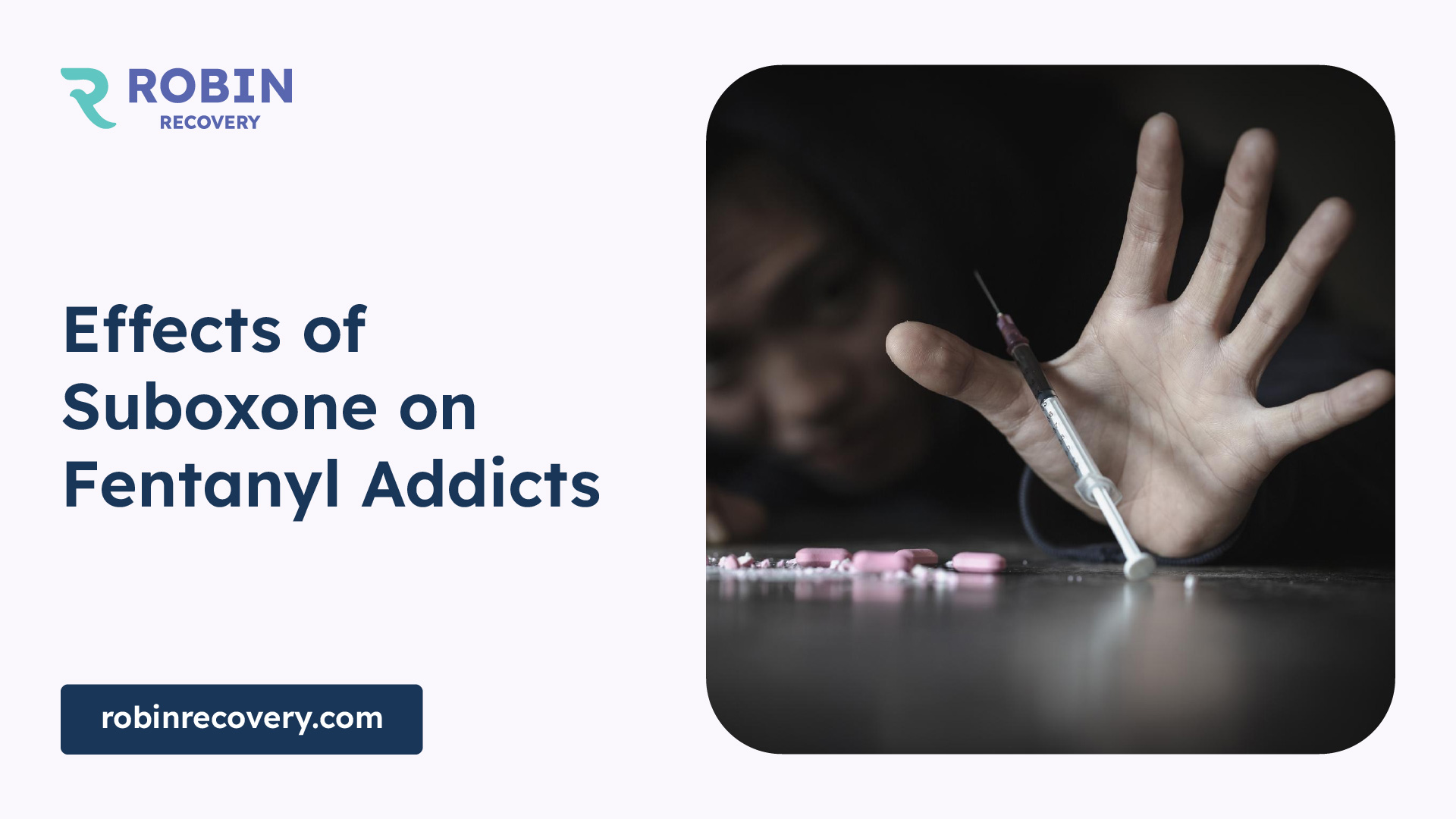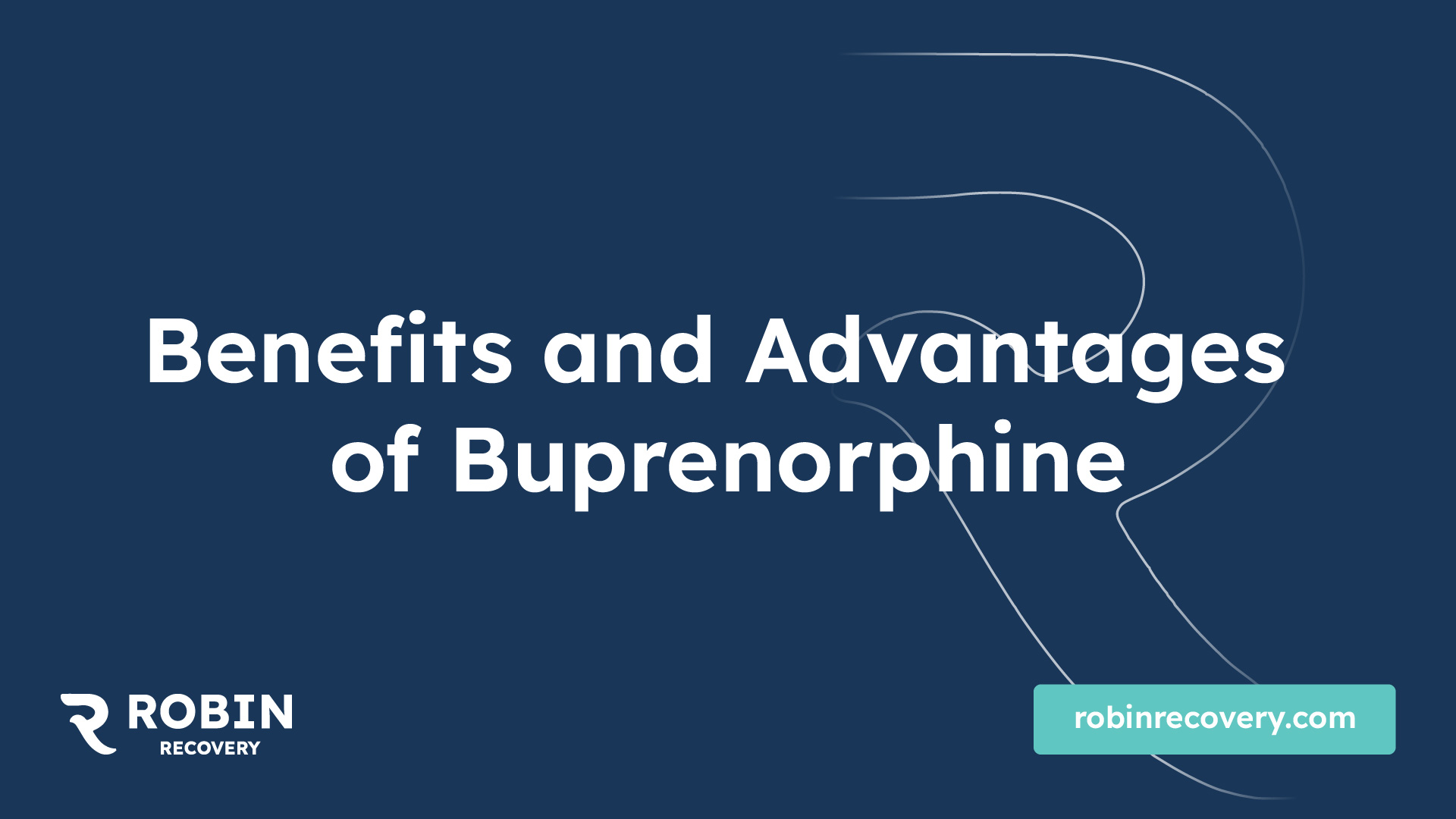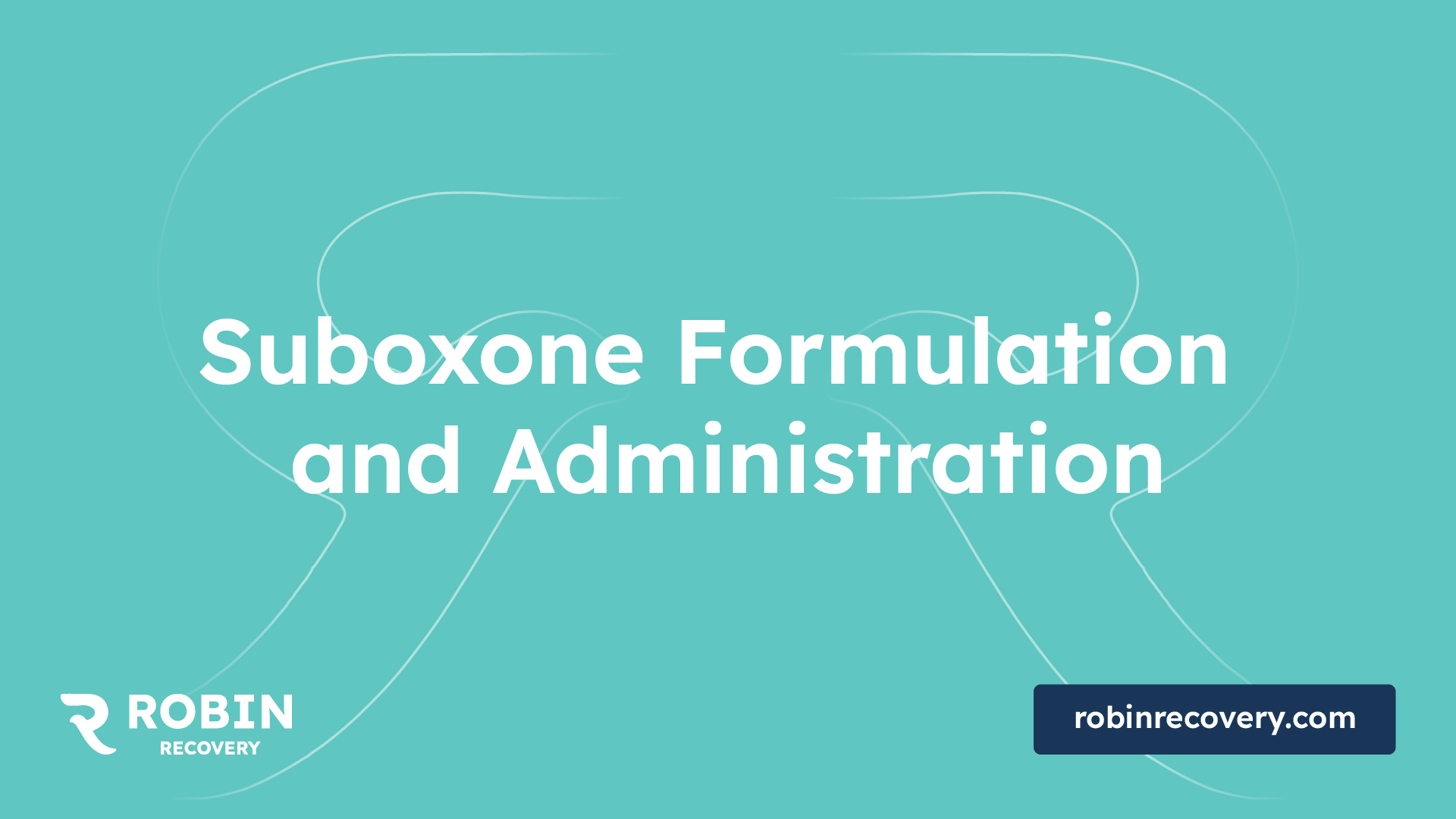Effects of Suboxone on Fentanyl Addicts


Understanding Suboxone Use
Suboxone is a medication commonly used in the treatment of opioid addiction, including those who use fentanyl. It combines two active ingredients, buprenorphine and naloxone, to help individuals reduce opioid misuse and stay engaged in treatment. In this section, we will explore the effectiveness of Suboxone and its classification.
Effectiveness of Suboxone
Clinical trials have shown that Suboxone is effective in reducing opioid misuse and keeping individuals with opioid dependence in treatment over a period of 24 weeks [1]. It works by binding to the same receptors in the brain that opioids target, effectively reducing cravings and withdrawal symptoms. By reducing these symptoms, Suboxone helps individuals manage their addiction and transition towards recovery.
It's important to note that Suboxone should always be used in conjunction with comprehensive addiction treatment programs that include counseling and behavioral therapies. These additional components help address the underlying causes of addiction and provide individuals with the tools and support needed for long-term recovery.
Classification of Suboxone
Suboxone is classified as a Schedule III prescription drug. This classification indicates that it has an accepted medical use but may cause physical or psychological dependence and has a risk of being misused. As a prescription medication, Suboxone should only be taken under the supervision and guidance of a healthcare professional who specializes in addiction medicine.
The classification of Suboxone highlights the importance of using it as part of a comprehensive treatment plan and following the prescribed dosage. It is essential to work closely with a healthcare provider to ensure the safe and effective use of Suboxone in managing fentanyl addiction.
Understanding the effectiveness and classification of Suboxone provides valuable insights into its role in treating opioid addiction, including fentanyl dependence. It is crucial to consult with a healthcare professional to determine if Suboxone is a suitable option for an individual's specific needs, as part of a personalized treatment plan.
Risks and Side Effects of Suboxone
When considering the use of Suboxone for individuals who are addicted to fentanyl, it's important to be aware of the potential risks and side effects associated with this medication.
Severe Risks of Suboxone
Suboxone can pose severe risks, especially when misused or used in high doses, or when combined with other drugs such as opioids, alcohol, or benzodiazepines. These risks include:
- Breathing Problems: Taking high doses of Suboxone can cause severe breathing problems, which can lead to coma or even death.
- Drug Interactions: Suboxone can interact with other substances, particularly opioids, alcohol, or benzodiazepines, increasing the risk of respiratory depression and other adverse effects.
To ensure safety when using Suboxone, it is crucial to follow the prescribed dosage and avoid combining it with any substances without medical supervision. If you are unsure about potential drug interactions, consult with a healthcare professional.
Long-Term Effects of Suboxone
Long-term use of Suboxone may lead to physical and psychological dependence, as well as drug-craving and drug-seeking behavior. It is important to note that dependence on Suboxone is not the same as addiction. Dependence refers to the body's reliance on the medication, while addiction involves compulsive drug-seeking behavior despite negative consequences.
Some potential long-term effects of Suboxone use include:
- Misuse and Overdose: Prolonged use of Suboxone can lead to misuse and overdose. It is essential to use Suboxone as directed and under the supervision of a healthcare professional.
- Psychological Dependence: Long-term use of Suboxone may result in psychological dependence, where individuals may experience cravings or a perceived need for the medication.
It is crucial to have regular check-ups with a healthcare provider while using Suboxone to monitor your progress, manage any potential side effects, and ensure the appropriate duration of treatment.
Understanding and discussing the potential risks and long-term effects of Suboxone with a healthcare professional is essential before starting treatment. They can provide guidance tailored to your individual needs and circumstances, helping you make informed decisions about your recovery journey.

Benefits and Advantages of Buprenorphine
When it comes to treating opioid addiction, buprenorphine, the main component of Suboxone, offers several benefits and advantages over other medications. Understanding the mechanism of buprenorphine and its superiority can provide valuable insights into its effectiveness in combating fentanyl addiction.
Mechanism of Buprenorphine
Buprenorphine, a long-acting, high-affinity partial agonist at the mu-opioid receptor, acts as a key player in opioid addiction treatment. Unlike full opioid agonists, such as fentanyl, buprenorphine has inherent abuse deterrence properties due to its partial agonist-antagonist nature. It prevents withdrawal symptoms and cravings, stabilizes opioid receptors, and blocks other opioids from binding, thus reducing the risk of abuse of other opioids.
The long-acting nature of buprenorphine allows for less frequent dosing, contributing to improved treatment adherence and reducing the burden of daily medication requirements. Its low overdose risk and absence of intoxication in opioid-dependent individuals make it a safer option for long-term maintenance therapy.
Superiority of Buprenorphine
Numerous studies have demonstrated the superiority of buprenorphine over other treatment options. In terms of tolerability, buprenorphine has been found to be superior to methadone, another commonly used medication for opioid addiction treatment [2]. Additionally, buprenorphine has been shown to be equivalent or superior to antagonist-based treatments, such as depot intramuscular and oral naltrexone.
One of the significant advantages of buprenorphine is its impact on mortality rates. Research has indicated that buprenorphine significantly lowers the risk of mortality and adverse outcomes compared to abstinence-based therapy or detoxification alone. It also demonstrates a reduction in all-cause and overdose mortality, improving the overall well-being and quality of life ratings of individuals undergoing treatment.
Furthermore, buprenorphine has proven effective in reducing the transmission rates of HIV and hepatitis C among individuals with opioid addiction. By providing a stable treatment option, buprenorphine helps individuals maintain healthier behaviors and reduce the risk of infectious diseases.
Buprenorphine has also emerged as the preferred treatment for pregnant women with opioid dependence. According to the 2017 guidelines from the American College of Obstetricians and Gynecologists, buprenorphine is safer than methadone or medical withdrawal during pregnancy. Studies have shown better neonatal outcomes when pregnant women with opioid dependence are treated with buprenorphine compared to methadone [2].
By understanding the mechanism of buprenorphine and recognizing its superiority in terms of safety and effectiveness, healthcare providers can confidently utilize this medication in their efforts to combat fentanyl addiction. The benefits of buprenorphine extend beyond mere symptom relief, providing individuals with a pathway to recovery and a chance at a healthier and more fulfilling life.
Buprenorphine in Treating Opioid Addiction
Buprenorphine, a key component of Suboxone, has shown promising results in the treatment of opioid addiction, particularly in individuals who use fentanyl. In this section, we will explore two important aspects of buprenorphine treatment: its impact on mortality rates and its effectiveness as a preferred treatment for pregnant women.
Impact on Mortality Rates
Research has shown that buprenorphine significantly lowers the risk of mortality and adverse outcomes compared to abstinence-based therapy or detoxification alone [2]. Individuals receiving buprenorphine treatment experience reduced all-cause and overdose mortality rates, leading to improved patient outcomes and increased chances of recovery. Moreover, the use of buprenorphine has also been associated with improved quality of life ratings and reduced rates of HIV and hepatitis C transmission among individuals with opioid addiction.
Preferred Treatment for Pregnant Women
According to the 2017 American College of Obstetricians and Gynecologists guidelines, buprenorphine is the preferred treatment for opioid-dependent pregnant women [2]. Compared to other treatment options like methadone or medical withdrawal, buprenorphine has been found to be safer for both the mother and the developing fetus. Studies have shown better neonatal outcomes in babies born to mothers receiving buprenorphine treatment compared to those on methadone. This preference for buprenorphine treatment in pregnant women reflects its efficacy and safety profile in this specific population.
While buprenorphine offers numerous benefits in treating opioid addiction, it's important to be aware of the potential risks and side effects associated with its use. Misuse of buprenorphine, especially through self-injection, has been linked to severe respiratory depression, coma, and even death [3]. Additionally, concomitant use of buprenorphine and benzodiazepines has been associated with adverse outcomes, including coma and death, particularly when misused through self-injection.
Different formulations of buprenorphine have been developed to enhance treatment options for individuals stabilized on buprenorphine. These include subdermal buprenorphine implants and once-monthly buprenorphine injections, which eliminate the need for daily dosing and provide convenience for patients in their recovery journey. These formulations offer alternatives that can improve treatment adherence and reduce the burden of daily medication administration.
Buprenorphine's impact on mortality rates and its effectiveness as a preferred treatment option for pregnant women make it a valuable tool in combating opioid addiction, including fentanyl addiction. However, it's crucial to consult with healthcare professionals and follow prescribed treatment plans to ensure safe and effective use of buprenorphine in the journey towards recovery.

Suboxone Formulation and Administration
To understand the effects of Suboxone on individuals who use fentanyl, it is important to explore the composition and administration of Suboxone. Suboxone is a medication used in the treatment of opioid addiction, and it contains two main components: buprenorphine and naloxone.
Composition of Suboxone
Suboxone is formulated with four parts buprenorphine and one part naloxone. Buprenorphine is a partial opioid agonist that binds to the same receptors in the brain as opioids but produces milder effects. It tricks the brain into thinking it is receiving a full dose of an opioid, which helps reduce cravings and withdrawal symptoms. Naloxone, on the other hand, is an opioid receptor antagonist that blocks the activation of opioid receptors. It is included in Suboxone to prevent misuse and abuse of the medication by discouraging injection or snorting, as naloxone can cause withdrawal symptoms if taken inappropriately. The combination of buprenorphine and naloxone in Suboxone helps individuals manage their addiction while minimizing the risk of misuse or overdose.
Phases of Suboxone Treatment
The administration of Suboxone typically involves four phases: induction, stabilization, maintenance, and taper phases. Each phase is designed to support individuals in their journey towards recovery from opioid addiction.
- Induction: In the induction phase, a healthcare provider determines the appropriate dose of Suboxone based on the individual's specific needs and opioid use history. The initial dose is usually administered when the individual is experiencing mild to moderate withdrawal symptoms.
- Stabilization: Once the induction phase is complete, the stabilization phase begins. During this phase, the healthcare provider aims to achieve a stable dose of Suboxone that effectively manages withdrawal symptoms and cravings. Counseling and support services are often provided alongside medication to address the psychological aspects of addiction.
- Maintenance: In the maintenance phase, individuals continue to take the stabilized dose of Suboxone as part of their ongoing treatment plan. Regular check-ins with healthcare providers and counseling sessions help individuals maintain their progress in recovery and address any challenges that may arise.
- Taper: The taper phase involves gradually reducing the dose of Suboxone over time. The duration of this phase varies from person to person, depending on their progress and individual circumstances. The tapering process allows the individual's body to adjust to decreasing levels of Suboxone until it is no longer needed.
It's important to note that the administration and duration of Suboxone treatment may vary depending on the individual's specific needs and the healthcare provider's recommendations. The goal of Suboxone treatment is to support individuals in overcoming opioid addiction and to help them lead productive, fulfilling lives. If you or someone you know is struggling with opioid addiction, it is essential to seek professional help from a healthcare provider or addiction specialist.
For more information on Suboxone and its effects on opioid addiction, consult our previous sections on the effectiveness and risks associated with Suboxone.
Suboxone Withdrawal and Risks
Suboxone, a medication used in the treatment of opioid addiction, can be beneficial for individuals struggling with fentanyl addiction. However, it is important to understand the potential risks and withdrawal symptoms associated with Suboxone use.
Withdrawal Symptoms of Suboxone
Abruptly stopping the use of Suboxone or using it too soon after taking heroin or other opioids can lead to withdrawal symptoms. These symptoms may include muscle aches, sweating, nausea, and restlessness [5]. It is crucial to follow a proper tapering schedule under the guidance of a healthcare professional to minimize the risk of withdrawal symptoms and ensure a successful transition.
Potential Risks of Suboxone
While Suboxone can be an effective tool in opioid addiction treatment, there are potential risks associated with its use. Misusing Suboxone, taking it in high doses, or using it in combination with other substances like opioids, alcohol, or benzodiazepines can lead to severe breathing problems, coma, and even death. It is important to use Suboxone strictly as prescribed by a healthcare professional and avoid any misuse or unauthorized use.
Buprenorphine, the main active ingredient in Suboxone, has been associated with significant respiratory depression, coma, and death, especially when misused through self-injection [3]. The concomitant use of buprenorphine and benzodiazepines has also been linked to coma and death, particularly when misused through self-injection. It is important to be aware of these risks and follow the prescribed guidelines for Suboxone use.
It is worth noting that Suboxone, if taken at higher doses, without a prescription, or in any way other than intended, can still lead to addiction and overdose. Some individuals may attempt to inject the drug to bypass its time-release qualities, increasing the risk of overdose. It is essential to use Suboxone as prescribed and seek professional help to ensure its safe and effective use.
Understanding the potential risks and withdrawal symptoms associated with Suboxone use is crucial for individuals seeking treatment for fentanyl addiction. It is always recommended to consult with a healthcare professional who can guide you through the treatment process and provide the necessary support to ensure a successful recovery.
References
[1]: https://www.medicalnewstoday.com/articles/325827
[2]: https://www.ncbi.nlm.nih.gov/pmc/articles/PMC5855417/
[3]: https://www.drugs.com/sfx/suboxone-side-effects.html
[4]: https://nida.nih.gov/publications/research-reports/medications-to-treat-opioid-addiction/how-do-medications-to-treat-opioid-addiction-work
